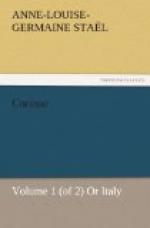Chapter iv.
The next day Oswald and Corinne set out with more confidence and serenity. They were friends travelling together;—they began to say we. Ah! how touching is that we when pronounced by love! How timidly, yet how vividly expressed, is the declaration which it contains! “We will go to the Capitol then,” said Corinne. “Yes, we will go there,” replied Oswald. Simplicity was in his words—softness and tenderness in his accent. “From the height of the Capitol, such as it is now,” said Corinne, “we can easily perceive the seven hills; we will survey them all, one after another; there is not one of them which does not preserve in it some traces of history.”
Corinne and Lord Nelville took what was formerly called the Via Sacra or Triumphal Way. “’Tis this way that your car passed,” said Oswald to Corinne. “Yes,” answered she; “this ancient dust might be astonished at bearing such a car; but since the Roman republic, so many criminal traces have been imprinted on it that the sentiment of respect which it inspires is much weakened.” They then arrived at the foot of the steps of the present Capitol. The entrance to the ancient Capitol was through the Forum. “I could wish,” said Corinne, “that these steps were the same that Scipio mounted, when, repelling calumny by glory, he entered the temple to return thanks to the gods for the victories which he had gained. But these new steps, this new Capitol, has been built upon the ruins of the old, in order to receive the peaceable magistrate who bears in himself alone the immense title of Roman Senator, formerly an object of respect to the whole universe. Here we have no longer any thing but names; yet their harmony, their ancient dignity, inspire us with a pleasing sensation, mingled with regret. I asked a poor woman, whom I met the other day, where she lived? ‘At the Tarpeian Rock,’ answered she. This word, however stripped of the ideas which formerly attached to it, still vibrates upon the imagination.”
Oswald and Corinne stopped to contemplate the two lions of basalt at the foot of the steps[11]. They came from Egypt. The Egyptian sculptors were more happy in seizing the figure of animals than that of man. These lions of the Capitol are nobly peaceful, and their physiognomy is the true image of tranquillity in strength.
“A guisa di leon, quando
si posa.”
DANTE.
“In the manner of the lion, when he reposes.”
Not far from these lions is a statue of Rome, mutilated, which the modern Romans have placed there, without thinking that they were thus giving the most perfect emblem of their city as it now is. This statue has neither head nor feet, but the body and the drapery which still remain have something of their ancient beauty. At the top of the steps are two colossal figures which represent as it is believed Castor and Pollux; then the trophies of Marius; then two milliary columns which served for the admeasurement of the Roman universe; and the equestrian statue of Marcus Aurelius, noble and calm in the midst of these several recollections. Thus, the whole Roman history is here emblematically represented: The heroic age by the Dioscuri; the republic by the lions; the civil wars by Marius; and the golden age of the emperors by Marcus Aurelius.




